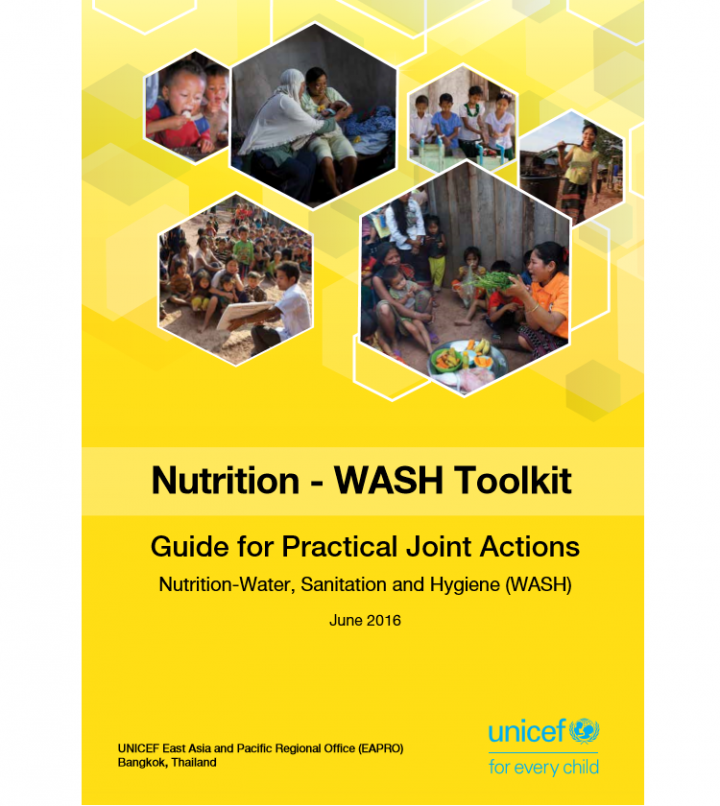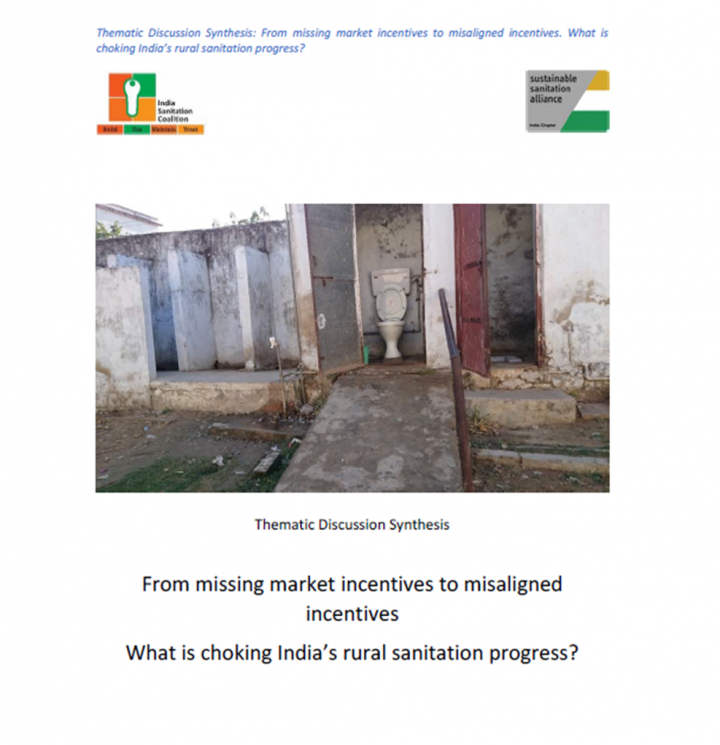SuSanA (2017) A Guideline to Organise SuSanA Thematic Discussion Series
This guideline will assist SuSanA partners and all other organisations that are interested in organising a thematic discussion on the SuSanA Forum during the planning process. It provides helpful background information and recommendations on what to keep in mind to organise a successful thematic discussion. The guidelines have been developed based on feedback and recommendations received from previous discussions, including a variety of best practice […]
Walther, D. (2017) Waste to Energy Plant in Nashik Brochure - SNUSP II
Like many cities in India, the city of Nashik is also struggling with citywide Solid Waste and Wastewater management. Therefore, there is an urgent need for an integrated approach to solid waste and wastewater management on the one hand and control of Green House Gas (GHG) emissions on the other hand. The Waste to Energy Project in Nashik is one such solution through co-processing of […]
UNICEF (2016) Nutrition - WASH Toolkit Guide for Practical Joint Actions
Undernutrition is a major cause of disease and death, affecting billions of people worldwide, especially women and children in impoverished communities. In the East Asia and Pacific (EAP) region, despite economic growth, and achievements in health and nutrition indicators, maternal and child malnutrition rates and burden remain high. Almost 28 million children are stunted in the EAP region, with one third of those children in […]
Jacob, N. (2018) From missing market incentives to misaligned incentives. What is choking India’s rural sanitation progress? Synthesis Document - SuSanA India Chapter thematic online discussion
Under the umbrella of the SuSanA Indian Chapter, the India Sanitation Coalition in partnership with Population Services International (PSI) and SuSanA, held a four-week thematic discussion on India's national rural sanitation programme, the Swachh Bharat Mission‐Gramin (SBM‐G). Starting point for the discussion were findings from a PSI policy landscape study that reviewed existing literature and conducted key informant interviews to understand SBM‐G, key functions and […]
Global WASH Cluster (2016) Cash and Markets In The WASH Sector A global WASH Cluster position paper
Market based programming is increasingly heralded as having a critical place in the future of humanitarian programming. The proposed benefits of working through existing market systems include improvements to speed, efficiency and effectiveness of programming and increased beneficiary dignity and choice. Advocates for market based approaches claim that, where feasible, they promote economic recovery, resilience, acceptance and sustainability. This paper seeks to: - locate CTP within the […]
Salian, P., Kibuuka A., Niwagaba, C. (2017) Town Sanitation Planning and District Investment Planning approaches in 6 towns and 4 districts in northern Uganda, and developing a Town Sanitation Plan strategy Lessons Learnt Report
GIZ-RUWASS program is supporting the improvement of the Ugandan water and sanitation sector through various projects. Amongst these projects is the USAID and GIZ co-funded project 'Capacity development of Town Councils to design and implement integrated and sustainable town sanitation plans'. The objective of the project is to make use of Town Sanitation Plans as a basis for planning and prioritizing investments resulting in tangible […]
GIZ (2017) Toolbox for PTM Process Step 5 - Sustainability & Integration
A collection of tools and reference material for the fifth step of the Public Toilet Management process and its focal areas is available for download here.
GIZ (2017) Toolbox for PTM Process Step 4 - Monitoring
A collection of tools and reference material for the fourth step of the Public Toilet Management process and its focal areas is available for download here.
GIZ (2017) Toolbox for PTM Process Step 3 - Implementation
A collection of tools and reference material for the third step of the Public Toilet Management process and its focal areas is available for download here.
GIZ (2017) Toolbox for PTM Process Step 2 - Planning and Strategy
A collection of tools and reference material for the second step of the Public Toilet Management process and its focal areas is available for download here.
GIZ (2017) Toolbox for PTM Process Step 1 - Supply and Demand Assessment
A collection of tools and reference material for the first step of the Public Toilet Management process and its focal areas is available for download here.
WaterAid (2017) Gender Equality and Disability Inclusion within water, sanitation and hygiene Exploring integrated approaches to addressing inequality
Addressing gender inequality and disability rights is critical to a rights-based approach to water, sanitation and hygiene (WASH) programming. Rights-based WASH should reflect all human rights principles, including ‘equality and non-discrimination’, and ‘participation and inclusion’. Approaching WASH with an inclusive lens is essential for achieving universal acces. This paper centres around two main questions: 1. How can the WASH sector continue to improve practice on gender and disability? 2. […]
Caruso,B. A., Clasen, T. F. , Hadley, C., Yount, K. M., Haardörfer, R., Rout, M., Dasmohapatra, M., Cooper, H. L. (2017) Understanding and defining sanitation insecurity: women’s gendered experiences of urination, defecation and menstruation in rural Odisha, India
Background Research suggests that the lived experience of inadequate sanitation may contribute to poor health outcomes above and beyond pathogen exposure, particularly among women. The goal of this research was to understand women’s lived experiences of sanitation by documenting their urination-related, defecation-related and menstruation-related concerns, to use findings to develop a definition of sanitation insecurity among women in low-income settings and to develop a conceptual […]
Wendland, C., Yadav M., Stock, A. and Seager, J. (2017) Gender, Women and Sanitation
Women and girls are especially affected by inadequate sanitation because of gender related differences - cultural and social factors - but also because of sex-related differences - physiological factors. Gender refers to the social differences and relations between men and women which are learned and often constructed and which differ in various societies and can change over time. There are tremendous socio-economic benefits associated with improved […]
Routray, P., Torondel, B., Clasen, T., Schmidt, W. (2017) Women’s role in sanitation decision making in rural coastal Odisha, India
While women and girls face special risks from lack of access to sanitation facilities, their ability to participate and influence household-level sanitation is not well understood. This paper examines the association between women’s decision-making autonomy and latrine construction in rural areas of Odisha, India. A mixed-method study among rural households was conducted in Puri district. This included a cross sectional survey among 475 randomly selected households. […]
Baker KK, Padhi B, Torondel B, Das P, Dutta A, Sahoo, K. C., Das, B., Dreibelbis, R., Caruso, B., Freeman, M. C., Sager, L., Panigrahi, P. (2017) From menarche to menopause: A population-based assessment of water, sanitation, and hygiene risk factors for reproductive tract infection symptoms over life stages in rural girls and women in India
Women face greater challenges than men in accessing water, sanitation, and hygiene (WASH) resources to address their daily needs, and may respond to these challenges by adopting unsafe practices that increase the risk of reproductive tract infections (RTIs). WASH practices may change as women transition through socially-defined life stage experiences, like marriage and pregnancy. Thus, the relationship between WASH practices and RTIs might vary across […]
WaterAid (2017) Out of Order The State of the World's Toilets 2017
A lack of decent toilets and clean water causes diarrhoeal diseases that, on average, claim the lives of almost 800 children every day – one every two minutes. The health impacts of poor sanitation trap people in poverty, making it difficult to get an education or to work to support their families. The State of the World’s Toilets 2017 explores how the lack of decent toilets […]
Grant M., Huggett C., Willetts J. & Wilbur J. (2017) Gender Equality & Goal 6: The Critical Connection
Sustainable Development Goal 6 (Goal 6) to ‘ensure availability and sustainable management of water and sanitation for all’ requires explicit attention to gender equality and inclusion. Universal access to safely managed water, sanitation and hygiene (WASH) and appropriate management of water resources will only be achieved if the rights of women and marginalised people are fulfilled. The human right to water and sanitation (UN […]
Lala, S., Cronic, A.A., Basu, M., Nirvana, J. (2017) Conceptualizing a Hybrid Framework to Help Improve Gender Outcomes in Water, Sanitation and Hygiene Programs in India
A gender-sensitive approach to ensure equity in WASH programs can achieve positive and sustainable outcomes, including participatory decisionmaking and empowerment of women. Gender analysis frameworks have a long history in development practice to guide strengthened gender outcomes, and opportunities exist to learn from such frameworks to support implementation of WASH programs in developing countries, including India. This paper reviews seven well-established gender analysis frameworks from […]
UNICEF (2017) Gender-Responsive Water, Sanitation and Hygiene: Key elements for effective WASH programming
Effective gender-responsive programming in the Water, Sanitation and Hygiene (WASH) sector can contribute to progress towards gender equality and important WASH results. This document outlines essential elements that WASH practitioners should take into account at all points in the programme cycle in order to enhance a gender-responsive approach to their work. Ensuring that women and girls have an equal role in the design, management and monitoring […]




















